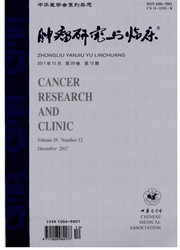

 中文摘要:
中文摘要:
目的 阐明磁共振成像(MRI)与血清血管内皮生长因子(VEGF)联合检测对脑膜瘤与胶质瘤鉴别诊断准确度的评价方法。方法 按设计的统一标准,收集2010年3月至2012年10月于山西省肿瘤医院神经外科住院的术后经病理确诊的胶质瘤或脑膜瘤患者114例,其中脑膜瘤患者50例,胶质瘤患者64例。在入院常规检查基础上,进行MRI平扫及增强扫描、血清VEGF、碱性磷酸酶(ALP)和乳酸脱氢酶(LDH)等检查。采用协变量(T2WI、VEGF)影响的受试者工作特征(ROC)曲线回归分析,完成鉴别诊断准确度评价。结果 VEGF对胶质瘤与脑膜瘤鉴别诊断的准确度较高,ROC曲线下面积为91.34 %;在考虑边缘清晰度等因素后,根据MRI T2WI信号特征,采用MRI与VEGF联合检测的分层鉴别诊断。根据临床意义,MRI检查T2WI为等信号时,VEGF鉴别诊断准确度更高,ROC曲线下面积为97.62 %,而低信号时为90.00 %,高信号时为88.34 %。结论 根据MRI T2WI信号特征联合检测VEGF含量,采用ROC曲线模型分析,可以提高对脑膜瘤与胶质瘤鉴别诊断的准确度。
 英文摘要:
英文摘要:
Objective To clarify evaluation methodology of the accuracy of differential diagnosis of meningioma and glioma, taking magnetic resonance imaging (MRI) and vascular endothelial growth factor (VEGF) into account. Methods According to the unified standard of design, 114 cases were selected, which were diagnosed by postoperative pathological in Shanxi Cancer Hospital from March 2010 to October 2012.On the basis of hospital routine inspection, all patients needed MRI scan, enhancement scan, VEGF, ALP and LDH, with pathological diagnosis of glioma or meningioma. Using ROC curve analysis which took VEGF, T2WI into account, the accuracy of differential diagnosis could be evaluated. Results The results showed that the differential diagnosis accuracy were high relatively, the area under the ROC curve was 91.34 %. When the T2WI were equisignal, low signal or high signal respectively, the area under the curve ROC were 97.62 %, 90.00 %, 88.34 %. Conclusion To consider the MRI T2WI and VEGF, ROC curve regression model analysis can enhance the differential diagnosis accuracy of meningioma and glioma.
 同期刊论文项目
同期刊论文项目
 同项目期刊论文
同项目期刊论文
 期刊信息
期刊信息
